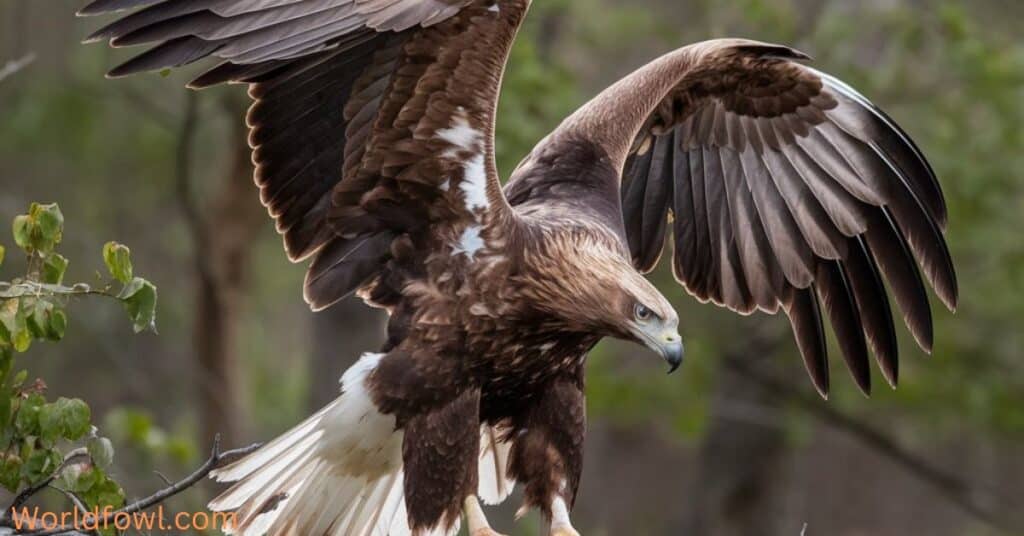For centuries, UK eagle species have captured our imagination, symbolizing power, freedom, and majesty. In the United Kingdom, these magnificent raptors have played a significant role in our natural heritage and continue to inspire awe among birders and nature enthusiasts alike. This comprehensive guide delves deep into the fascinating world of UK eagle species, their distribution across the country, and the ongoing efforts to protect and preserve these incredible birds of prey.
Introduction:
The United Kingdom boasts a rich tapestry of wildlife, and among its most impressive residents are the UK eagle species. These apex predators have long held a special place in British culture, from ancient Celtic mythology to modern conservation efforts. Today, two species of eagles grace the skies of the UK: the Golden Eagle (Aquila chrysaetos) and the White-tailed Eagle (Haliaeetus albicilla), both of which are iconic UK raptors.
A Brief History
Their populations have faced numerous challenges. Historical persecution, habitat loss, and environmental contamination led to significant declines in eagle numbers, with some species disappearing entirely from parts of the UK. However, recent decades have seen a renewed focus on conservation, resulting in the gradual recovery and reintroduction of these magnificent birds of prey.
UK Eagle Species: Meet the Masters of the Sky
Let’s take a closer look at the two UK eagle species that call the United Kingdom home, exploring their unique characteristics, behaviors, and habitats.
Golden Eagle (Aquila chrysaetos)
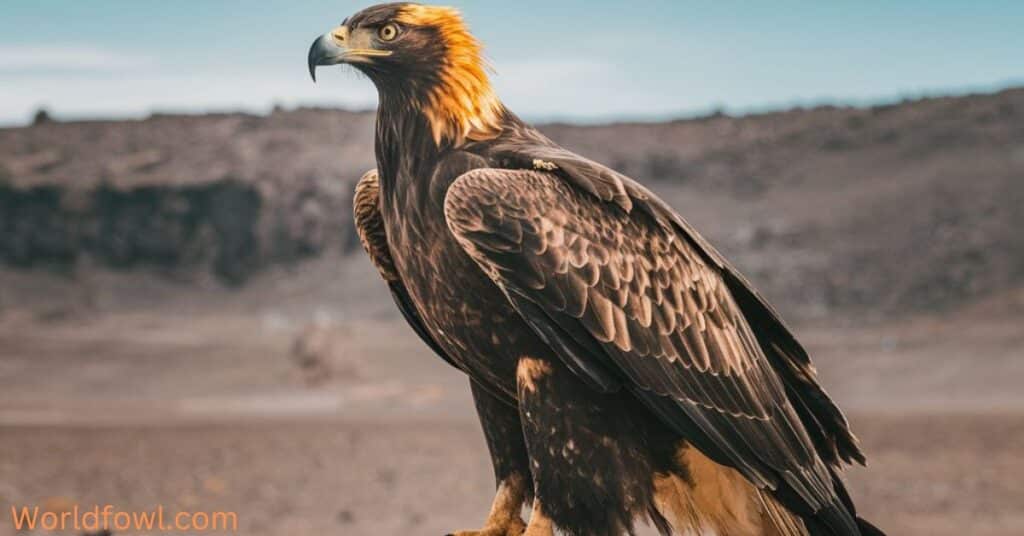
The Golden Eagle is a true icon of the Scottish Highlands and one of the most recognizable UK raptors. These powerful birds are known for their:
- Size: Wingspan of 1.8-2.3 meters (5.9-7.5 feet)
- Weight: 3-6.5 kg (6.6-14.3 lbs)
- Plumage: Dark brown with golden-brown nape feathers
- Lifespan: Up to 30 years in the wild
Habitat and Distribution
Golden Eagles prefer open moorlands, mountains, and forested areas. In the UK, they’re primarily found in:
- Scotland (particularly the Highlands and Western Isles)
- Small populations in northern England
- Historically present in Wales, with potential for future reintroduction
Diet and Hunting Behavior
These formidable predators have a varied diet, including:
- Medium-sized mammals (hares, rabbits)
- Birds (grouse, ptarmigan)
- Occasional scavenging on carrion
Golden Eagles are known for their impressive hunting skills, using their keen eyesight to spot prey from great distances before swooping down at speeds of up to 150 mph.
you may also like : Do Hawks Hunt At Night – The Truth Revealed
White-tailed Eagle (Haliaeetus albicilla)
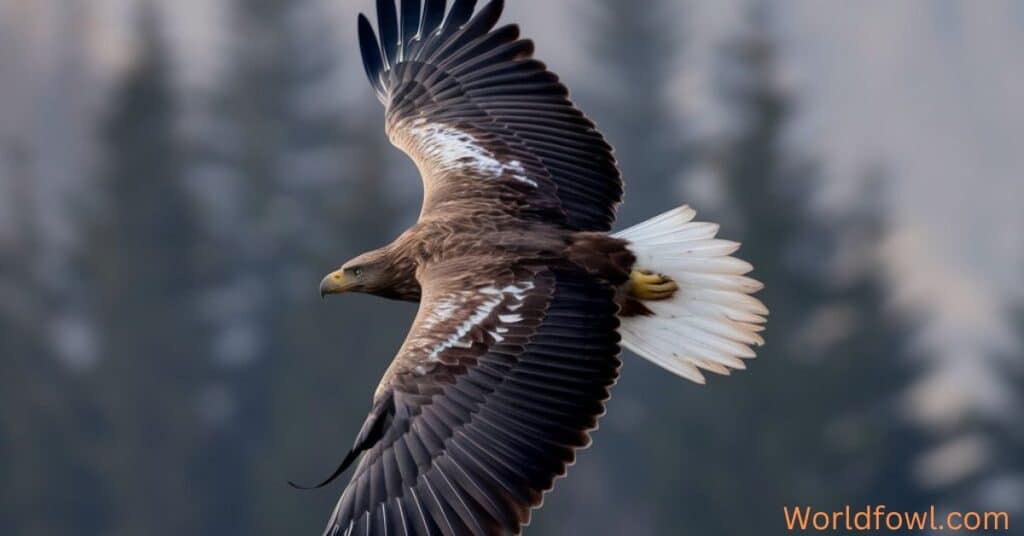
Also known as the Sea Eagle, the White-tailed Eagle is the UK’s largest bird of prey and an impressive member of the UK eagle species. Key features include:
- Size: Wingspan of 2-2.5 meters (6.6-8.2 feet)
- Weight: 4-7 kg (8.8-15.4 lbs)
- Plumage: Brown body with pale head and distinctive white tail
- Lifespan: Up to 25 years in the wild
Habitat and Distribution
White-tailed Eagles, another notable UK eagle species, are typically found in coastal areas and large bodies of water. In the UK, they inhabit:
- Western Scotland (including the Hebrides)
- East coast of Scotland
- Reintroduced populations in England (Isle of Wight, Norfolk)
Diet and Hunting Behavior
These versatile hunters have a diverse diet:
- Fish (their primary food source)
- Waterbirds
- Small mammals
- Occasionally scavenge on carrion
White-tailed Eagles are known for their impressive fishing abilities, snatching prey from the water’s surface with their powerful talons.
Distribution Across the United Kingdom
The presence of UK eagle species varies significantly across the different countries of the United Kingdom. Let’s explore their distribution in detail, highlighting the unique characteristics of each region.
Eagles in Scotland: The UK Eagle Species Stronghold
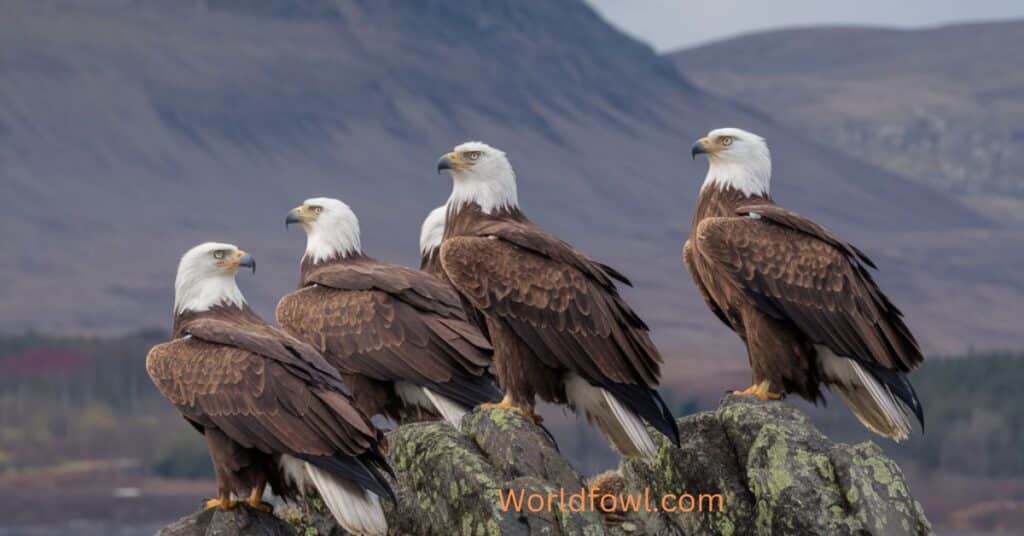
Scotland is undoubtedly the eagle capital of the UK, hosting the largest populations of both Golden and White-tailed Eagles. The rugged landscapes and diverse ecosystems of Scotland provide ideal habitats for these magnificent.
you also like : Do Hawks Attack Humans? Why Are Hawks Aggressive To People?
Golden Eagles in Scotland
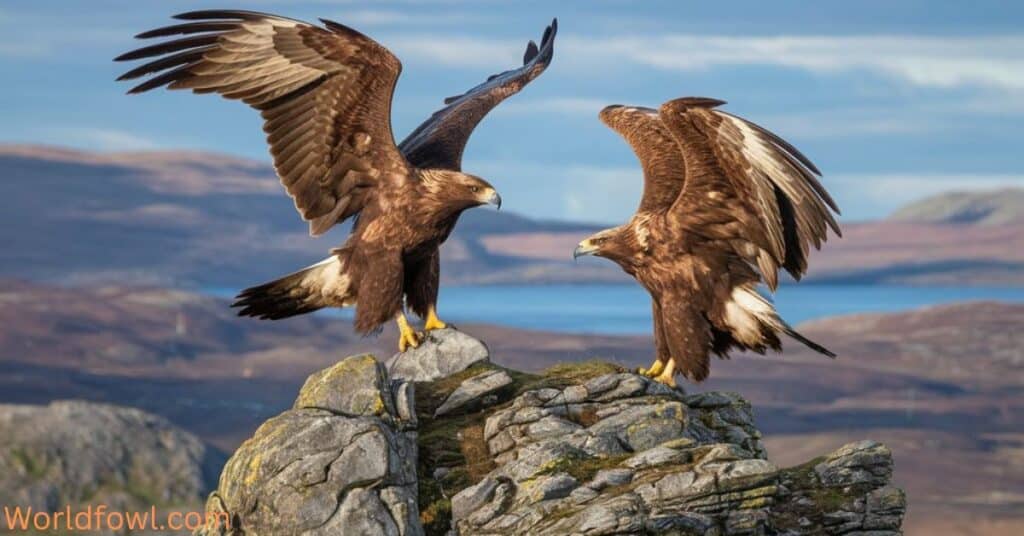
- Population: Approximately 440 breeding pairs
- Key Areas:
- Cairngorms National Park
- Isle of Skye
- Western Highlands
Population in Scotland represents the stronghold for this UK eagle species, with the birds thriving in the remote and mountainous regions of the country.
White-tailed Eagles in Scotland
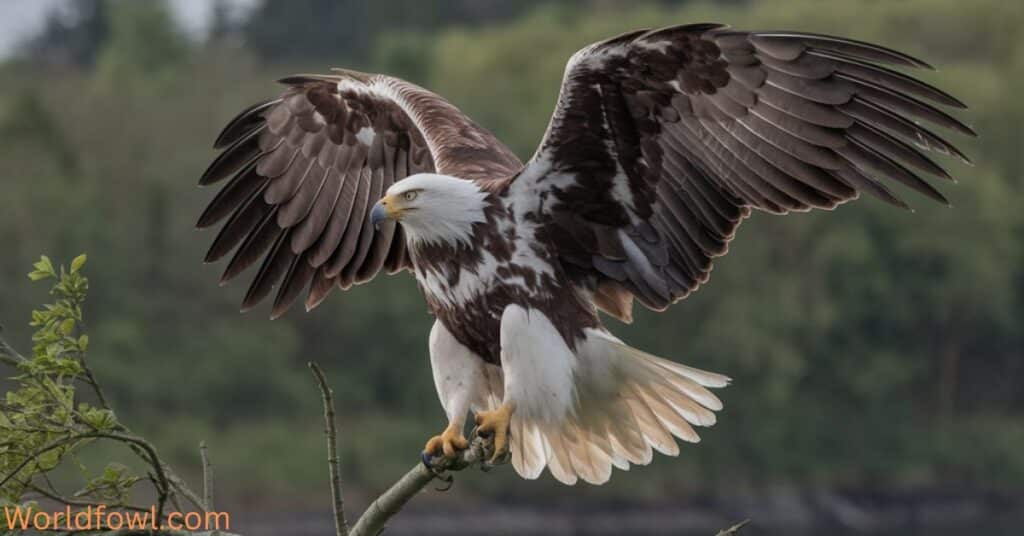
- Population: Over 150 breeding pairs
- Key Areas:
- Isle of Mull
- Outer Hebrides
- East coast (Fife to Aberdeenshire)
The successful reintroduction of White-tailed Eagles to Scotland has been a landmark achievement.
“The return of the White-tailed Eagle to Scotland is one of our greatest conservation success stories.” – RSPB Scotland
Eagles in England: A Tale of Return
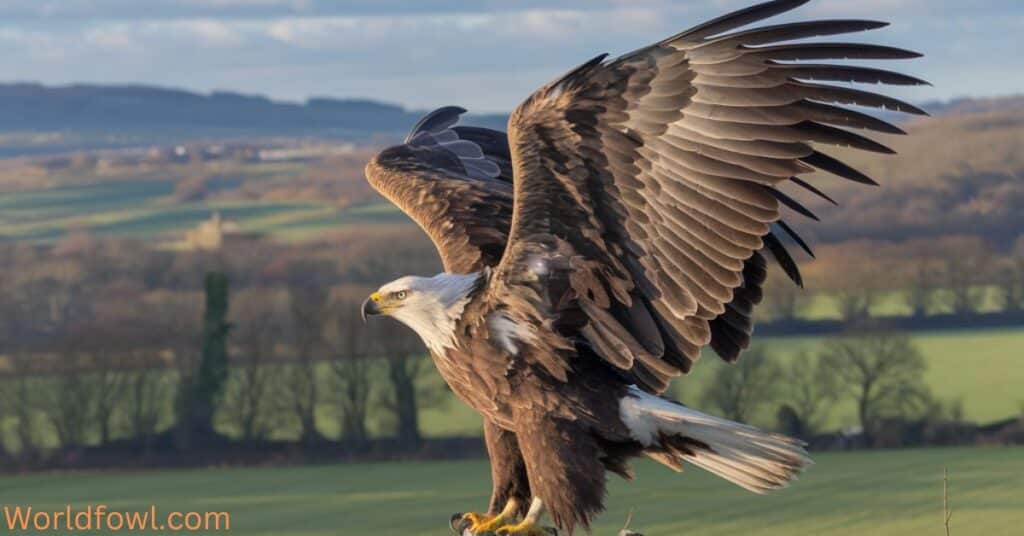
While eagles were once extinct in England, recent reintroduction efforts have brought these magnificent UK eagle species back to English skies, marking a new chapter in the story of UK raptors.
Golden Eagles in England
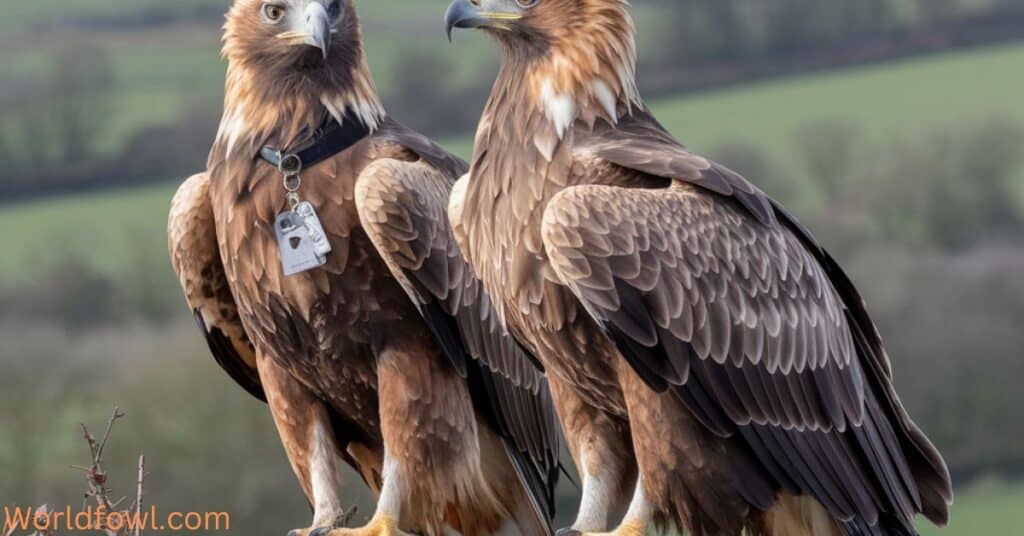
- Population: 1-2 pairs in northern England
- Key Areas:
- North Pennines
- Lake District (potential future habitat)
The presence of Golden Eagles in England is tenuous but represents a glimmer of hope for the expansion of this range.
White-tailed Eagles in England
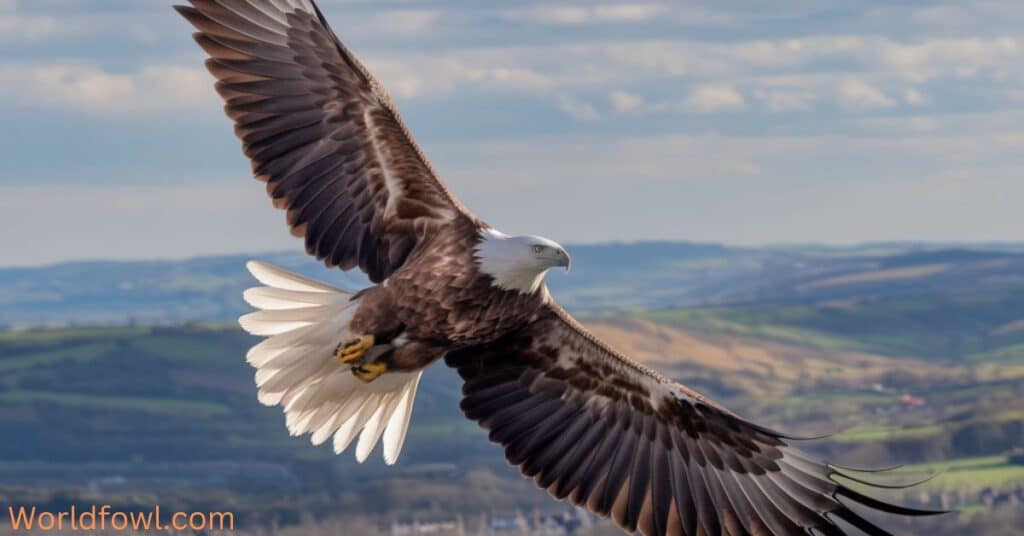
- Reintroduction: Ongoing project on the Isle of Wight
- Future Plans: Potential releases in Norfolk and Suffolk
The reintroduction of White-tailed Eagles to England is an exciting development for conservation, offering new opportunities for these birds to reclaim their historic territories.
Wales and Northern Ireland: Potential Recovery
Currently, neither Wales nor Northern Ireland has breeding populations. However, there’s potential for future reintroductions:
- Wales: Habitat assessments for potential Golden Eagle reintroduction
- Northern Ireland: Occasional sightings of eagles from Scotland and Ireland
The possibility of reintroducing UK eagle species to these regions offers hope for a more comprehensive distribution of these magnificent birds across the United Kingdom.
Population Numbers and Trends
Understanding the population dynamics. Here’s a breakdown of the latest estimates and trends for these UK raptors:
Golden Eagle Population in the UK
| Region | Estimated Breeding Pairs | Trend |
| Scotland | 440 | Stable |
| England | 1-2 | Fluctuating |
| Wales | 0 | N/A |
| N. Ireland | 0 | N/A |
White-tailed Eagle Population in the UK
| Region | Estimated Breeding Pairs | Trend |
| Scotland | 150+ | Increasing |
| England | 5-10 (reintroduced) | Establishing |
| Wales | 0 | N/A |
| N. Ireland | 0 | N/A |
These population figures highlight the ongoing challenges and successes in UK eagle species conservation, demonstrating the importance of continued efforts to protect and expand their presence across the United Kingdom.
you might like : Where Do Hummingbirds Go At Night? Hummingbird Night Life Exposed
Conservation Efforts and Challenges
Protecting and preserving requires ongoing efforts and faces various challenges. Conservation initiatives play a crucial role in ensuring the survival and prosperity of these magnificent UK raptors.
Key Conservation Initiatives
- Habitat Protection: Designating and managing protected areas crucial
- Reintroduction Programs: Carefully planned releases of captive-bred birds to expand the range
- Nest Site Protection: Monitoring and safeguarding known nesting locations
- Public Education: Raising awareness about conservation and their importance in the ecosystem
Challenges Facing UK Eagle Species
- Habitat Loss: Development and land-use changes affecting UK eagle species territories
- Human Persecution: Illegal killing and disturbance
- Climate Change: Altering prey availability and breeding patterns
- Wind Farms: Potential collision risks
“Conservation success depends on collaboration between landowners, conservationists, and local communities.” – Scottish Natural Heritage
Observing UK Eagle Species in the Wild: A Birder’s Guide
For birders and nature enthusiasts, witnessing UK eagle species in their natural habitat is an unforgettable experience. Here are some tips for responsible eagle watching:
Best Practices for Watching
- Keep Your Distance: Use binoculars or spotting scopes to observe
- Respect Nesting Sites: Avoid disturbing breeding areas , especially during sensitive periods
- Follow Local Guidelines: Adhere to any specific rules or regulations in protected areas
- Leave No Trace: Minimize your impact on the environment while observing
Top UK Eagle Species Viewing Locations
- Mull Eagle Watch, Scotland: Guided tours to see White-tailed Eagles, one of the UK’s impressive eagle species
- Glenmore Forest Park, Scotland: Golden Eagle watching opportunities, showcasing another of the UK’s majestic eagle species
- Hawk Conservancy Trust, England: Educational displays and flying demonstrations featuring
- Isle of Wight, England: Potential sightings of reintroduced White-tailed Eagles, a recent addition to England’s UK eagle species
you might also like : Can Seagulls Breathe Underwater? How Do Seagulls Avoid Drowning?
in Culture and Economy
The presence in the United Kingdom has far-reaching impacts beyond their ecological role, influencing various aspects of British culture and economy.
Tourism and Economic Benefits
- Wildlife Tourism: Eagle watching attracts visitors to rural areas, boosting local economies
- Job Creation: Tour guides, conservation workers, and related services focused
- Local Business Boost: Increased demand for accommodation and dining in areas where can be observed
UK Eagle Species in Art and Literature
Eagles have long inspired British artists and writers, with UK eagle species featuring prominently in various forms of cultural expression:
- Poetry: From William Wordsworth to Ted Hughes, UK eagle species have been a source of poetic inspiration
- Visual Arts: Prominent in Scottish and Celtic artwork
- Literature: UK eagle species have been featured in numerous nature writings and novels, capturing the imagination of readers
Future Outlook
The future in the United Kingdom looks promising, but continued efforts are necessary to ensure their long-term survival and expansion across the country.
Potential Developments
- Expanded Reintroductions: Possible releases in new areas of England and Wales
- Habitat Restoration: Improving and connecting suitable habitats
- Advanced Monitoring: Using GPS tracking and remote sensing technologies to study
- Climate Adaptation: Developing strategies to help UK eagle species cope with environmental changes
Research and Scientific Studies
Ongoing research plays a crucial role in understanding and protecting . Here are some key areas of scientific inquiry:
Genetic Studies of UK Eagle Species
Researchers are using DNA analysis to:
- Assess genetic diversity within UK eagle species populations
- Trace lineages and understand population movements
- Identify potential inbreeding issues in small populations
Behavioral Ecology
Scientists are studying:
- Hunting patterns and prey preferences
- Breeding behaviors and nest site selection
- Territorial behaviors and interactions between UK eagle species
Migration Patterns
Tracking studies are revealing:
- Seasonal movements
- Dispersal patterns of young eagles
- Potential impacts of climate change on migration routes
Conservation Genetics and UK Eagle Species
Research is focused on:
- Developing breeding programs .
- Assessing the genetic health of reintroduced populations
- Identifying key genetic traits for adaptation to changing environments
UK Eagle Species and Ecosystem Health
As apex predators, these birds play a crucial role in maintaining ecological balance.
Trophic Cascades and UK Eagle Species
The presence can influence entire ecosystems:
- Regulating prey populations
- Influencing the behavior of other predators
- Maintaining biodiversity through predation pressure
you may also like : Do Robins Mate For Life? The Complete Guide To Robin Romance
as Bioindicators
Eagles can serve as early warning systems for environmental issues:
- Accumulation of pollutants in eagle tissues indicates environmental contamination
- Changes in eagle populations can signal shifts in ecosystem health
- Breeding success rates reflect overall habitat quality
Public Engagement and UK Eagle Species Conservation
Engaging the public is crucial for the long-term conservation . Various initiatives aim to connect people with these magnificent birds:
Citizen Science Projects
- Encouraging public participation
- Using smartphone apps for reporting eagle sightings
- Involving volunteers in nest protection programs
Educational Programs
- School visits and workshops focused on UK eagle species
- Interpretive centers at key eagle watching locations
- Online resources and webinars
Community Conservation Initiatives
- Working with local communities to protect
- Developing sustainable ecotourism around UK eagle species
- Engaging landowners in eagle-friendly land management practices
Conclusion: Soaring Towards a Brighter Future
United Kingdom is a testament to the power of conservation and the resilience of nature. As we continue to work towards protecting these magnificent birds of prey, we not only preserve an important part of our natural heritage but also maintain the delicate balance of our ecosystems.
Respecting their habitats, and sharing our knowledge with others, we can ensure that future generations will have the opportunity to witness the awe-inspiring sight of eagles soaring over the British landscape.
Whether you’re an avid birder, a nature enthusiast, or simply someone who appreciates the beauty of wildlife, the UK eagle species offer a powerful reminder of the importance of protecting our natural world. As we look to the future, let’s continue to champion these majestic birds and the wild places they call home.
The story is one of resilience, conservation success, and ongoing challenges. From the rugged highlands of Scotland to the reintroduction sites in England, these magnificent birds continue to inspire and amaze. As we move forward, the conservation will require ongoing collaboration between scientists, conservationists, policymakers, and the public.
By working together, we can ensure that the skies of the United Kingdom will always be graced by the presence , serving as a testament to our commitment to preserving the natural wonders of our world for generations to come.

Henry James is a seasoned blogger and a passionate storyteller on “World Fowl.” With years of experience crafting engaging content, he brings a unique blend of expertise and creativity to his writing. Henry specializes in exploring diverse topics with depth and clarity, captivating readers worldwide.

